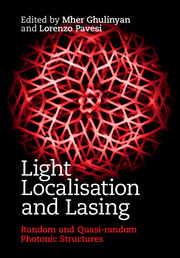Book contents
- Frontmatter
- Contents
- List of contributors
- Preface
- 1 Light propagation and emission in complex photonic media
- 2 Transport of localized waves via modes and channels
- 3 Modes structure and interaction in random lasers
- 4 Ordered and disordered light transport in coupled microring resonators
- 5 One-dimensional photonic quasicrystals
- 6 2D pseudo-random and deterministic aperiodic lasers
- 7 Three-dimensional photonic quasicrystals and deterministic aperiodic structures
- 8 Cavity quantum electrodynamics with three-dimensional photonic band gap crystals
- References
- Index
1 - Light propagation and emission in complex photonic media
Published online by Cambridge University Press: 18 December 2014
- Frontmatter
- Contents
- List of contributors
- Preface
- 1 Light propagation and emission in complex photonic media
- 2 Transport of localized waves via modes and channels
- 3 Modes structure and interaction in random lasers
- 4 Ordered and disordered light transport in coupled microring resonators
- 5 One-dimensional photonic quasicrystals
- 6 2D pseudo-random and deterministic aperiodic lasers
- 7 Three-dimensional photonic quasicrystals and deterministic aperiodic structures
- 8 Cavity quantum electrodynamics with three-dimensional photonic band gap crystals
- References
- Index
Summary
General overview
In many areas in the physical sciences, the propagation of waves in complex mediaplays a central role. Acoustics, applied mathematics, elastics, environmental sciences, mechanics, marine sciences, medical sciences, microwaves, and seismology are just a few examples, and of course nanophotonics [6, 429, 448, 449]. Here, complex media are understood to exhibit a strongly inhomogeneous spatial structure, which determines to a large extent their linear and nonlinear properties. Examples of complex media are random, heterogeneous, porous, and fractal media. The challenges that researchers in these areas must surmount to describe, understand, and ultimately predict wave propagation are formidable. Right from the start of this field – in the early 1900s – it was clear that new concepts and major approximations had to be introduced. Famous examples of such concepts are the effective medium theory [55, 60, 321] and the radiative transport theory [81, 491]. These concepts are very much alive, even today. The fundamental challenge with these approximate concepts is that often the length scales of the inhomogeneities in the complex medium are comparable with the wavelength, whereas the range of validity of these approximations is restricted to situations where these length scales are much larger than the wavelength. Consequently, many relevant situations arise where either the effective medium theory, or radiative transport theory, or both, fail dramatically. Examples of such situations are given in this introduction and throughout this book.
The complexity of the medium that supports wave propagation can be classified in a number of ways. Many different types of spatial inhomogeneities in a host matrix can be envisioned, varying from completely random, via aperiodic and waveguide structures, to quasi-crystalline and even structures with long-range periodic order. The in homogeneities could be of a self-organized form, or the fruit of precise engineering. An additional classification is whether or not the complexity is confined to the surface (in two dimensions (2D)) or is present throughout the volume of the medium (in three dimensions (3D)), as in porous media.
- Type
- Chapter
- Information
- Light Localisation and LasingRandom and Pseudo-random Photonic Structures, pp. 1 - 12Publisher: Cambridge University PressPrint publication year: 2014
- 1
- Cited by



